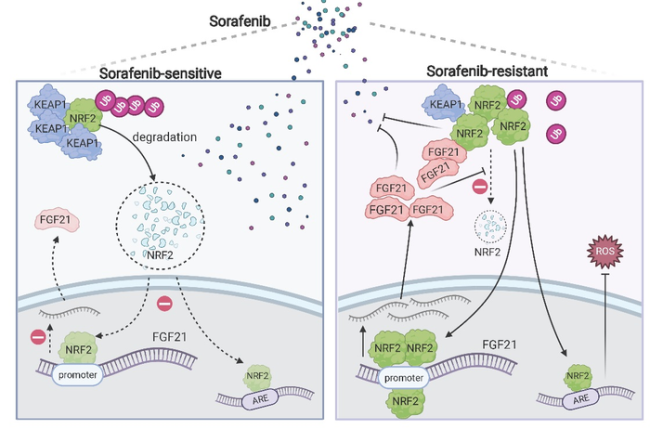Recent research headed by Professor Xiujun Cai (Department of General Surgery, Sir Run-Run Shaw Hospital, Zhejiang University School of Medicine) used the CRISPR/cas9 system to screen the entire genome of hepatocellular carcinoma cells (HepG2) under sorafenib treatment and found the dominant gene in sorafenib resistance—KEAP1.
 Nrf2 and FGF21 positively regulate each other to form a positive feedback pathway and induce sorafenib resistance. Image Credit: ©Science China Press.
Nrf2 and FGF21 positively regulate each other to form a positive feedback pathway and induce sorafenib resistance. Image Credit: ©Science China Press.
Nrf2, a downstream molecule controlled by Keap1, is critical for cells’ resistance to reactive oxygen species (ROS). To begin, this study used a large number of functional experiments to confirm the role of the KEAP1–Nrf2 axis in sorafenib resistance, such as identifying the IC50 of sorafenib in HCC cells using KEAP1/Nrf2 gene editing.
The current study discovered that ML385, a small molecule inhibitor of Nrf2, could improve the killing effect of sorafenib in vivo and in vitro.
FGF21 was discovered to be the most important downstream molecule of Nrf2 in the context of sorafenib resistance in hepatocellular carcinoma using bioinformatics tools and experimental verification such as qPCR. The role of classical transcription factors is used by Nrf2 to positively regulate the expression of FGF21.
FGF21 can positively control the expression of Nrf2 in vivo and in vitro, according to this study. FGF21 regulates Nrf2 at the protein level, and it can stabilize its protein by inhibiting Nrf2’s ubiquitination; further experiments, such as immunocoprecipitation, confirmed that FGF21 binds and stabilizes Nrf2 through its C-terminal.
They form a positive feedback regulatory system. FGF21 enhances its function in the KEAP1-Nrf2 pathway, allowing hepatocellular carcinoma cells to become resistant to sorafenib.
Source:
Journal reference:
Chen, J., et al. (2022) CRISPR-Cas9-based genome-wide screening identified novel targets for treating sorafenib-resistant hepatocellular carcinoma: a cross-talk between FGF21 and the NRF2 pathway. Science China Life Sciences. doi.org/10.1007/s11427-021-2067-7.